Why should PCB boards do impedance?
PCB impedance refers to the parameters of resistance and reactance, which plays anobstruction role in alternating current. In pcb circuit board production, impedance treatment is essential. So do you know why PCB circuit boards need to do impedance?
1, PCB circuit board bottom to consider the installation of electronic components, electrical conductivity and signal transmission performance after insertion, so it will require the lower the impedance, the better, the resistivity is less than 1×10-6 per square centimeter below.
2, PCB circuit board in the production process to experience copper sinking, tin plating (or electroless plating, or hot spray tin), solder joints and other process production links, and the materials used in these links must ensure that the resistivity bottom, in order to ensure that the overall impedance of PCB circuit board is low to meet the product quality requirements, can operate normally.
3, the tinning of PCB board is the most prone to problems in the production of the entire circuit board, and it is the key link affecting the impedance. The biggest defect of the chemical tin plating layer is easy discoloration (both easy oxidation or delixing), poor brazing, which will lead to difficult welding of the circuit board, high impedance leading to poor electrical conductivity or instability of the whole board performance.
4, PCB circuit board in the conductor will have a variety of signal transmission, when to improve its transmission rate and must increase its frequency, the line itself if the etching, laminated thickness, wire width and other factors are different, will cause the impedance is worth changing, so that the signal distortion, resulting in the board performance decline, so you need to control the impedance value in a certain range.
